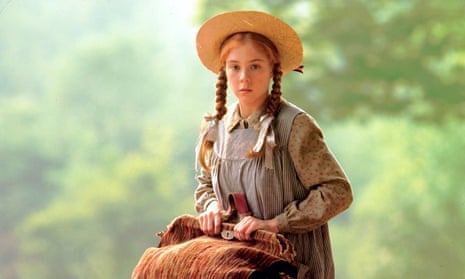I’ve just had a baby so I’m up a lot in the small hours, and when I can’t get back to sleep, I’ve been indulging in the guilty pleasure of reading everything I can find about the new TV adaptation of Anne of Green Gables. I read LM Montgomery’s 1908 novel and its seven sequels over and over as a girl. I’d get to the end of book eight and start again, with plucky red-headed orphan Anne Shirley waiting at a train station for her new life to begin. She taught me things I still think about every day.
Girls are just as good as boys
Matthew and his sister Marilla decide to get an orphan boy to help out on their farm and are miffed when, due to a mix-up, Anne arrives instead. But they soon admit she’s made them happier than a boy could have done. Anne doesn’t cede first place to any boy, and certainly not her school rival, roguish Gilbert Blythe. Their (spoiler alert) relationship gave me hope that even swots and misfits could find love.
Own your rage
When Gilbert teases her about her hair, Anne breaks a slate over his head. And she isn’t sorry. And he takes her anger seriously and respects her for it.
You can be bright and ambitious and still go nuts for a nice frock
Anne prays, “Please let me be good-looking when I grow up.” In any other children’s book – I’m looking at you, Little Women – she’d be punished for vanity. But Anne gets her dream dress, and her red hair even, eventually, goes auburn, just as she wished it would. Because what’s wrong with a bit of beauty?
Fun is a serious business
Anne’s mantra that “you can nearly always enjoy things if you make up your mind firmly that you will” is nothing like Pollyanna’s nauseating “glad game”. Anne has a gift for pleasure – whether she’s taking apple blossoms up to her bedroom “for company”, walking a ridgepole or savouring her first ice cream. She also – and this is almost revolutionary – thinks everyone has a right to joy.
Friendship is crucial
Anne taught me to be always on the lookout for “kindred spirits”, especially the unlikely (and supposedly unlikable) ones. My life is richer for it.
It’s never too late to open up to love
Marilla starts out stern, tart and repressed, her body all angles, her hair all pins, her experience narrow, her conscience rigid. Anne makes her laugh, challenges her assumptions and just loves her. Marilla mellows, and once her heart is open it stays open. She even adopts two more orphans.

Too much romance can be dangerous
Not only does Anne nearly drown while re-enacting “The Lady of Shalott” in a leaky barge, she faces an even more existential danger when her penchant for dark, inscrutable dreamboats with ridiculous names leads her to go out with vacant clothes horse Royal Gardner. For two whole years. Eventually, she realises that you have to actually be able to talk to The One, and that romantic heroes don’t have to look or sound a certain way.
But imagination can change the world
As a child I was always being told I had an “overactive imagination”, as though it was a terrible flaw. Anne showed me that while imagination could get you into trouble, you can also channel it. Anne uses her imagination to write, and also to put herself into other people’s shoes and work out how to make them feel better. I can only aspire to her radical altruism.
It’s OK to be odd
Anne is deeply peculiar, and she’s not embarrassed about it. She’s forever curious about other oddballs, eccentrics and outsiders, and in finding her own way to live, beyond the straitjackets of convention.
Some compromises are a compromise too far
Ironically, given where I’m at, I don’t want to learn from Anne when it comes to motherhood. I’m gutted that Anne becomes a smug married, subsumes herself in her children’s lives and fades out of view. In the final novel, she’s even referred to, in the narration, as “Mrs Blythe”. And why does she give up writing, saying she’s penning “living epistles” (ie bringing up her children)? It seems a compromise too far. It’s a relief to find Montgomery thought so, too. Miserably married to a jealous, depressive minister, and burdened with responsibilities and despair, Montgomery fulfilled all of Anne’s wishes, giving her heroine the perfect home life she wanted for herself. But it didn’t make her happy. Instead, Montgomery got sick of Anne so she rewrote her. Her other great heroine, Emily Byrd Starr, is much tougher. And she holds fast to her dreams.
Samantha Ellis is the author of How to Be a Heroine, and Take Courage: Anne Brontë and the Art of Life. Anne of Green Gables is on Netflix.

Comments (…)
Sign in or create your Guardian account to join the discussion